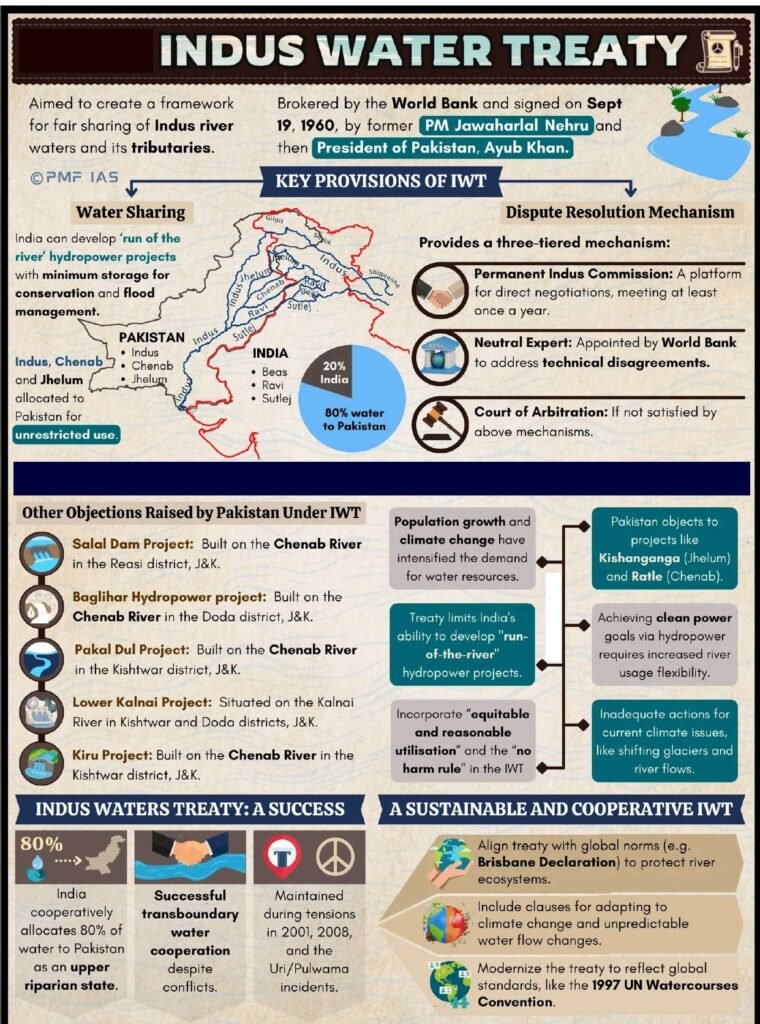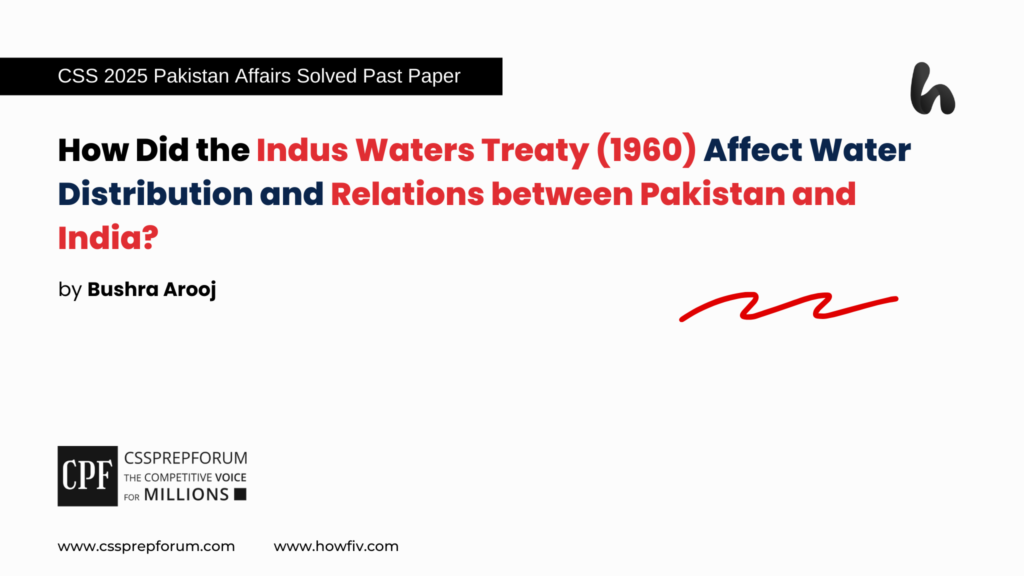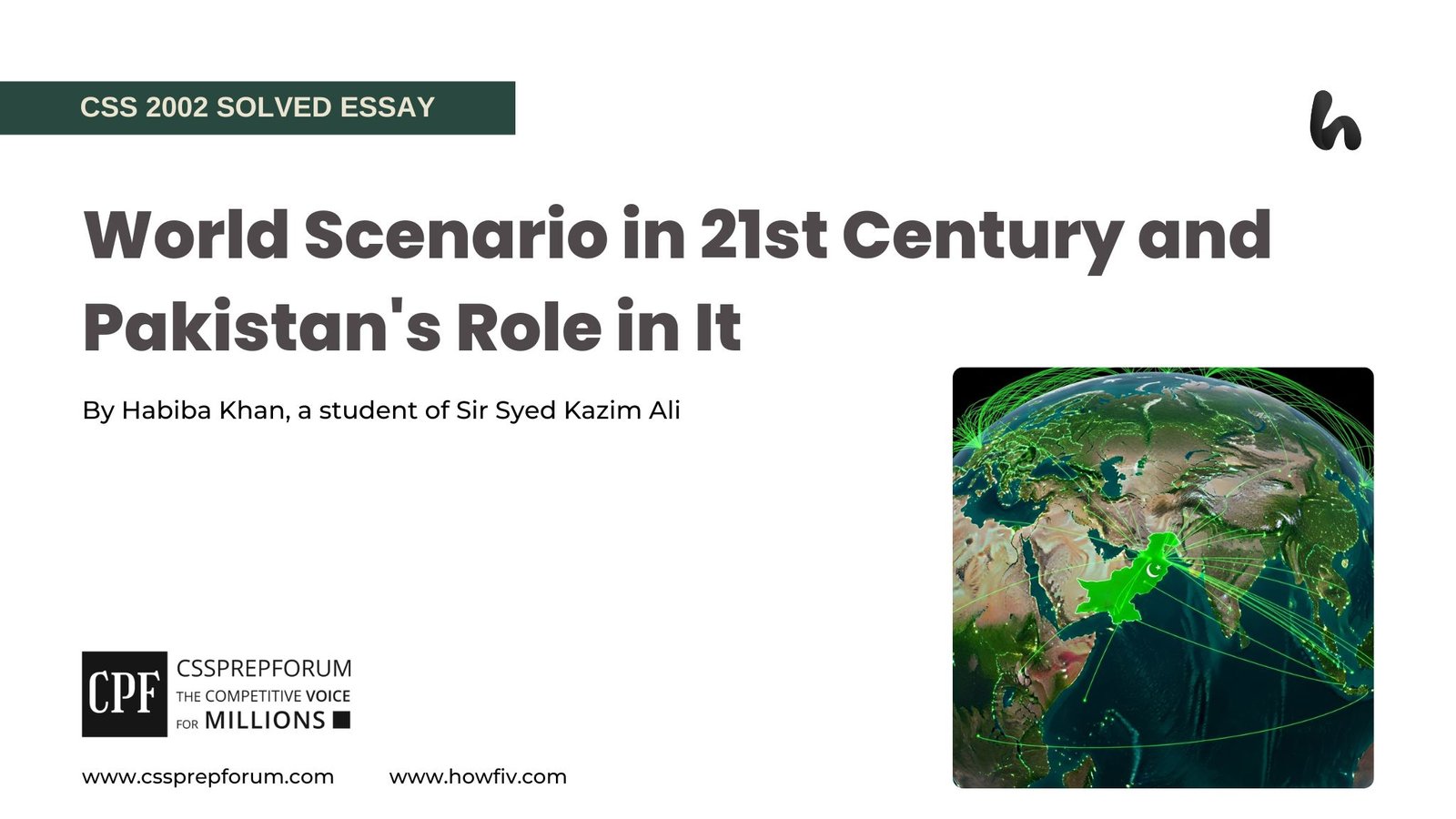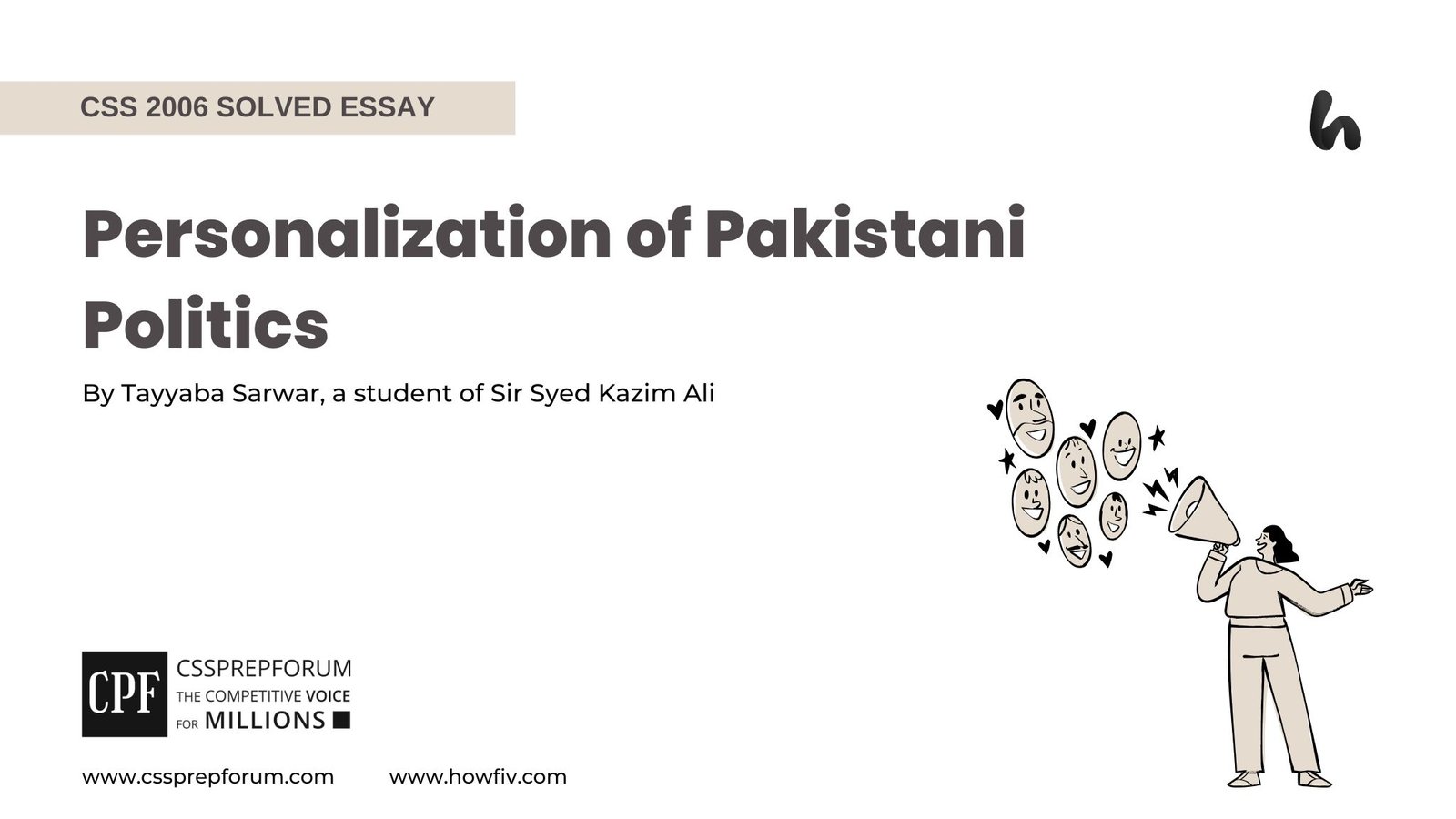CSS 2025 Solved Pakistan Affairs Past Papers | Indus Waters Treaty (1960) and Pakistan-India Relations
The following question of CSS Pakistan Affairs 2025 is solved by Miss Bushra Arooj, the best Pakistan Affairs Coach, on the guided pattern of Sir Syed Kazim Ali, which he taught to his students, scoring the highest marks in compulsory subjects for years. This solved past paper question is uploaded to help aspirants understand how to crack a topic or question, how to write relevantly, what coherence is, and how to include and connect ideas, opinions, and suggestions to score the maximum.

Outline
1-Introduction
2-Background of the Indus River System
3-Overview of the Indus Waters Treaty (IWT) and its Importance
4-Effects of Indus Water Treaty on Water Distribution between India and Pakistan
- ✓ Ecological Imbalances
- ✓ Over-extraction
- ✓ Potential Threats of Floods or Droughts for Pakistan
- ✓ Water Disruptions
5- Effects of Indus Water Treaty on Relations between India and Pakistan
5.1- Negative Impacts on Paki-India Relations
- ✓ Lower-riparian and upper-riparian disputes
- ✓ Increased militarization and regional instability
- ✓ Use of water as a political tool
- ✓ Growing concerns over water scarcity
5.2- Positive Impacts on Pak-India Relations
- ✓ Conflict Prevention
- ✓ Framework for cooperation and communication
- ✓ Prevention of water wars
- ✓ Infrastructure Development Support
7-Critical Analysis
- ✓ Political rhetoric and accusations of treaty violations
8-Conclusion

Answer to the Question
Introduction
The Indus River System, one of the largest river systems in the world, has been a lifeline for millions of people in South Asia, particularly in Pakistan and India. However, the management of its water resources has been a bone of contention between the two nations, especially considering the Indus Waters Treaty (IWT), signed in 1960. To elaborate, the treaty was framed to regulate the allocation and usage of the river’s waters, providing a framework for peaceful cooperation. However, as climate changes, water scarcity grows, and agricultural demands intensify, the implications of the treaty have become increasingly intricate. To conclude, the paper sheds light upon the multifaceted impacts of the IWT on water distribution and its broader implications for Pakistan-India relations. Furthermore, it also examines both the negative consequences, such as ecological imbalances and rising tensions, as well as the positive aspects, including conflict prevention and infrastructure development.

Background of the Indus River System
The Indus Water, one of the world’s longest rivers, originates from the Tibetan Plateau near Mount Kailash through India and Pakistan and empties into the Arabian Sea, flowing approximately 3,180 kilometres. However, the Indus Water had been a matter of contention and been the focus during the Indo-Pakistan War of 1947 between India and Pakistan. Therefore, after an eight-year long negotiation led by the World Bank, in 1960, a treaty was signed named the Indus Water Treaty, distributing water between both nations. Moreover, the treaty partitioned the basin by allotting the unrestricted use of the three eastern rivers – the Ravi, Beas, and Sutlej – to India, and the three Western rivers – the Indus, Chenab, and Jhelum – to Pakistan. A little over half of the basin’s total irrigated area lies within Pakistan, which supplies 90 per cent of its agricultural production. Pakistan, whose West Punjab province was extensively irrigated by the British, leveraged its historical claims to secure roughly 80 per cent of the Indus waters’ distribution. Around 20 per cent was reserved for India. However, India also gained limited rights of ‘non-consumptive’ use on the Western rivers, such as in irrigation, water storage and hydropower. Interestingly, despite surviving three wars and long-term rivalry, the treaty set a precedent of cooperation and collaboration between India and Pakistan, serving as a rare example of cooperation compromise.
Overview of the Indus Waters Treaty (IWT) and its Importance
Notably, before understanding the actual effects of the Indus Water Treaty on the water distribution and the relationship between Pakistan and India, it is imperative to initially have a key perception of the IWT and its significance.

- Key Provisions of the Treaty
To elaborate, signed on September 19, 1960, between India and Pakistan, the Inus Water Treaty serves as a landmark agreement that regulates the sharing of water from the Indus River, allocating eastern rivers to India and western rivers to Pakistan. According to this treaty, while India possesses thirty per cent of the waters of the Indus River, it has the right to utilize the western rivers for domestic and non-consumptive purposes, such as fishing, irrigation of 170,000 acres of land, and hydroelectric power generation. In the context of Pakistan, the Indus River Treaty assisted Pakistan in satiating its agricultural lands from Punjab to Sindh. However, since there is long-term hostility between both nations and to prevent the rise of future disputes, the IWT was signed and overseen by the Permanent Indus Commission (PIC), which consists of representatives from both countries who meet regularly to discuss operational issues and to ensure compliance with treaty terms as it provides a mechanism that addresses questions, differences, and disputes. Significantly, the treaty further emphasises cooperation in managing flood control and environmental protection and condemns any action that causes material damage to each other’s water resources. Thus, the treaty, despite the existence of potential geo-political tensions between both countries, has been playing a crucial role in maintaining peace over water resources.
Effects of the Indus Water Treaty on Water Distribution between India and Pakistan
Moreover, delving into the adverse effects of IWT, the following paragraphs shed light on the facts that how and why the IWT, one of the most valuable treaties of the world, can cause significant challenges.
- Ecological Imbalances
To begin, while the IWT was signed to distribute water equally, it has disrupted the natural flow of water, making the surrounding lands vulnerable to potential threats. For example, the flow has led to habitat degradation, loss of biodiversity, and increased salinity in agricultural lands, exacerbating the challenges faced by local farmers who heavily rely on consistent water supplies for irrigation. Therefore, even though the treaty gained importance, it is not proved to be eco-friendly.
- Over-extraction
Moreover, the treaty’s focus on surface water allocation and its disregard towards groundwater management has led to unsustainable practices in both India and Pakistan. As farmers are free to install tube wells and extract unlimited amounts of water without considering the long-term impact on the aquifer, the groundwater has become at an alarming rate of depletion. According to a NASA survey, the Indus Basin is now the second-most overstressed aquifer on the planet, with water levels falling by 4-6 mm per year. Therefore, the inattentiveness of the IWT has contributed to the over-extraction of water resources in the Indus Basin, particularly the groundwater.
- Potential Threats of Floods or Droughts for Pakistan from India
Besides, the IWT has highly made Pakistan vulnerable to potential upstream water-management decisions by India. As Pakistan fulfills seventy per cent of its irrigational needs from the three allocated rivers of the Indus Basin, which can be blocked at any time by India, in such case the nation, being a downstream nation, would face potential damage, such as floods or droughts to its agricultural lands. For example, during the first war over Kashmir, India did cut off the flow of the eastern river, causing one million acres in Pakistan to go into drought. Therefore, India’s rights over the eastern rivers would anytime threaten Pakistan’s land.
- Water Disruptions
Despite that, the treaty has inadvertently contributed to water disruptions in the Indus Basic, particularly affecting Pakistan as a lower-riparian state. India, permitted under certain conditions, continuously constructs dams and hydroelectric plants which disrupt the flow of water coming from upstream to downstream Pakistan. Several times, Pakistan has expressed its concerns about India’s projects, such as the Baglihar and Kishanganga hydroelectric plants, that they violate the treaty by disrupting water-flow patterns. Thus, these disruptions can have severe consequences for Pakistan’s agricultural sector, which heavily relies on regular water supplies from the Indus Basin.
Effects of the Indus Water Treaty on Water Distribution between India and Pakistan
A- Negative Impacts on Paki-India Relations
Moreover, along with its effects on water distribution, the IWT has also been used as a tool for political disputes between India and Pakistan.
- Lower-riparian and upper-riparian disputes
To begin, the IWT has exacerbated lower-riparian and upper-riparian disputes adversely worsening both the nations’ relations. With Pakistan being afraid of India’s construction of dams and hydroelectric projects that might deter water-flow patterns and India -as an upper-riparian- having greater control over the flow of rivers, this power imbalance could cause agricultural and food security threats, leading to concerns of geo-political tensions. Therefore, the misbalance of control over the Indus River would worsen the long-standing hostility between both countries.
- Increased militarization and regional instability
Notably, despite its initial success in preventing water wars, the treaty has become a source of tension, exacerbating existing conflicts. To elaborate, in 2023, India’s notice for modification of the treaty and boycotting the Court of Arbitration (CoA) and Pakistan’s objection over two hydroelectric projects (HEPs) by India, may lead to the need for updating the 64-year-old IWT, which may not only exacerbate the situation but also lead to increased militarization and regional instability as modification to IWT would be backbreaking work.
- Use of water as a political tool
Apart from that, the Indus Water Treaty has become a political tool in the fraught relationship of Pakistan and India. Unlike in the past, both nations, in response to the border tussles and geopolitical tensions, try to paralyze each other’s progress over the Indus River. For instance, following a terrorist attack in 2016 in Uri, Indian Prime Minister Narendera Modi has declared an statement that “water and blood cannot flow together” emphasizing that India could restrict the flow of water coming to the western river. As a response, Pakistan has objected over all the constructed dams and hydroelectric plants in Hague at Court of Arbitration (CoA). Therefore, both nations weaponize water issues to exert pressure on each other.
- Growing concerns over water scarcity
Lastly, both nations are grappling with water scarcity issues, which have become a source of tension between both countries. As water scarcity on both sides intensifies, the calls to update the treaty on new issues start growing. On the other hand, the World Bank’s role as a mediator has been strained, with disagreements often escalating to a higher level of arbitration. Therefore, the scarcity of water exacerbates the tensions between the countries, leading them to reconsider the IWT.
B- Positive Impacts on Pak-India Relations
Notwithstanding, the IWT has significantly contributed to long-term peace, cooperation, and collaboration between India and Pakistan despite going through four major wars and political tensions. The following paragraphs explore the significance of IWT it played and how it would play in future for both nations.
- Conflict Prevention
Significantly, despite four wars and numerous political tensions, IWT has played a significant role in preventing water wars, contributing positively to their relations. Owing to a clear framework for water distribution, dispute resolution mechanisms like PIC, and regular communication and data exchange, IWT has blocked all the chances for war and disputes and successfully addressed the questions and issues, accordingly leading to fair distribution of water. Therefore, the IWT has been proven to be rewarding in conflict prevention.
- Framework for cooperation and communication
Moreover, the treaty has laid the groundwork for cooperative and communicative work, leading both nations to perform in harmony. With alternation of PIC, India and Pakistan meet at least once a year, discuss operational issues, ensure compliance with treaty terms, and report all developments to each other’s party even during the heightened political tensions. Thus, the treaty’s resilience is evident in its survival through four wars and various political tensions, demonstrating its effectiveness.
- Infrastructure Development Support
Finally, the Indus Water Treaty has profoundly supported the infrastructure development of both countries. For instance, the treaty facilitated potential financial support for its major infrastructure projects as India contributed 62.06 million Euros ($4 billion today) for replacement work in Pakistan to support the transition, helping Pakistan to develop its canal system and utilize the water of Indus rivers. Likewise, in the case of India, the country has spurred the development of numerous hydroelectric projects, dams, irrigation systems, and so on. In this fashion, India has accelerated the planning and execution of several major hydroelectric projects, including Baglihar (900 MW), Kishanganga (330 MW), Ratle (850 MW), Sawalkote (1856 MW), Pakal Dul (1000 MW), not only enhancing India’s energy security but also contributing to the overall development of the region. Therefore, both India and Pakistan have achieved and have the potential to gain much more from the opportunity if they continue to work with collaboration and cooperation.
Critical Analysis
- Political rhetoric and accusations of treaty violations
To analyze critically, The Indus Waters Treaty (IWT) of 1960, undoubtedly, has become a focal point for political rhetoric and accusations of treaty violations between Pakistan and India, significantly impacting their relations. Critically, both nations have misused water issues as tools to exert pressure on each other, escalating tensions and undermining the treaty’s original purpose. India, as the upper riparian state, has leveraged its control over water resources. As declared by Prime Minister Modi, “blood and water cannot flow together,” implying substantial water restrictions in retaliation for cross-border terrorism. Pakistan, as a response, has accused India of “water terrorism,” particularly pointing to infrastructure projects like the Shahpurkandi barrage on the Ravi River. As a result, these accusations and politicization of water resources have led to speculation about the IWT’s powers within the public domain, further engraving mutual distrust. Therefore, this rhetoric has prevented both countries’ elites from creating goodwill and “social constituencies” that might strengthen the ties.
Conclusion
In a nutshell, the Indus Waters Treaty stands as a pivotal framework in the intricate web of water resource management and geopolitical relations between Pakistan and India. While it has contributed to conflict resolution and fostering cooperation, significant challenges remained still. On one side, the negative impacts on ecological balance, water distribution, and bilateral relations underscore the urgent need for both countries to engage in dialogue and collaborative management of their shared water resources. On the other side, as climate change exacerbates water scarcity and alters the dynamics of the region, the IWT gained much more importance. Therefore, it is imperative for both nations to move beyond political rhetoric and accusations, focusing instead on constructive engagement and innovative solutions. By fostering diplomatic ties, they can transform potential conflicts over water into opportunities for collaboration. Also, it requires a commitment to mutual understanding, respect for shared resources, and a willingness to adapt to the evolving challenges of water management in an increasingly interdependent world.

CSS 2025 Solved Pakistan Affairs
| 2- | How did the Indus Waters Treaty (1960) affect water distribution and relations between Pakistan and India? |
| 3- | Examine the causes and consequences of the 1971’separation of East Pakistan, highlighting the role of regional and international players. |
| 4- | Explore the significance of CPEC (China-Pakistan Economic Corridor) for the economic development of Pakistan. What are its (potential challenges and opportunities? |
| 5- | Analyze the demographic and cultural diversity of Pakistan and its impact on national integration and policymaking. |
| 6- | Critically evaluate the impact of Bhutto’s nationalization policy on the economy of Pakistan. |
| 7- | The Kashmir dispute is an unfinished agenda of the 1947 partition. Evaluate Pakistan’s Kashmir policy for the solution of the problem. |
| 8- | Is media a curse or blessing? Critically evaluate its role in shaping public opinion and influencing political events in Pakistan in the 21st century. |
CSS Solved Past Papers’ Essays
Looking for the last ten years of CSS and PMS Solved Essays and want to know how Sir Kazim’s students write and score the highest marks in the essays’ papers? Then, click on the CSS Solved Essays to start reading them.
CSS Solved Essays
CSS Solved General Science & Ability Past Papers
Want to read the last ten years’ General Science & Ability Solved Past Papers to learn how to attempt them and to score high? Let’s click on the link below to read them all freely. All past papers have been solved by Pakistan’s top CSS GSA coach having the highest score of their students.
General Science & Ability Solved Past Papers












